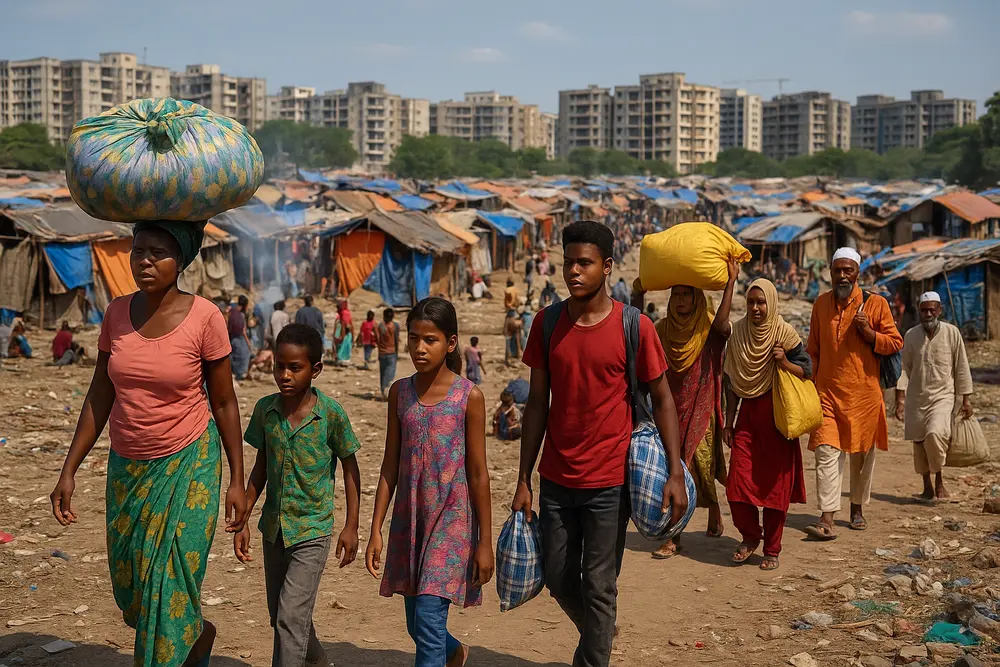How Climate Migration Is Reshaping Social Structures Worldwide
Climate migration refers to the movement of people driven by the impacts of climate change—whether sudden disasters like floods and hurricanes or slow-onset changes like drought, desertification, and rising sea levels.
Climate migration is rapidly transforming social structures across borders and generations. It’s not just about escaping danger; it’s often about seeking stability, livelihoods, and safety when environmental conditions make home uninhabitable.
As communities adapt to displacement and demographic shifts, new patterns of identity, cohesion, and cultural dynamics emerge. These changes challenge traditional norms while fostering resilience, hybrid communities, and evolving relationships among migrants and host societies.
The phenomenon is redefining how we live, connect, and build society in a warming world.
Let’s explore the impact of climate migration on modern social structures through a sociological lens.

The Impact of Climate Migration on Social Structures: A Sociological Study
The phenomenon of climate-induced migration is reshaping societies across the globe.
Climate migration is often called a “threat multiplier” because it intensifies existing social, economic, and political challenges. It’s reshaping demographics, urban planning, and even international relations.
As extreme weather events intensify and slow-onset hazards like sea-level rise and drought become more frequent, millions of individuals are compelled to relocate. This mass movement doesn’t merely cross borders—it transforms the very fabric of communities, altering social norms, economic relations, and cultural identities.
According to the Internal Displacement Monitoring Centre, 46.9 million new internal displacements occurred in 2023 alone, with 56% triggered by disasters such as floods, storms, and wildfires.
The World Bank’s Groundswell report projects that without decisive action, up to 216 million people may be forced to move within their countries by 2050, driven by climate-related factors like water scarcity, crop failure, and extreme heat.
In this article, we will present a sociological study on how climate migration impacts modern social structures. If policymakers, community leaders, and civil society understand these dynamics, they can craft more resilient, inclusive strategies to support populations on the move.
Drivers of Climate Migration and Shifting Social Norms
Climate migration is propelled by sudden disasters like hurricanes and long-term changes such as desertification.
In 2023 alone, floods displaced more than 1.2 million people in South Asia, while persistent drought in the Horn of Africa forced pastoralists to abandon ancestral grazing lands.
These shifts erode traditional social norms: youth must leave farming villages, elders lose roles as custodians of agricultural knowledge, and communal rituals tied to the land fade away.
A 2024 IOM study found that over 500,000 Bangladeshis relocated to Dhaka each year due to environmental stress, leading to both rural depopulation and urban overcrowding.
Conversationally, picture attending a harvest festival where half the families you grew up with are gone—fields lie fallow and stories of old ways go untold.
Yet, migrants carry traditions into new settings, blending customs and sparking both creative synergy and occasional friction as host communities adapt.
Urbanization Pressures: Climate Migrants in Mega-Cities
By 2050, an estimated 8 million climate migrants may settle in just ten Global South cities—Dhaka, Karachi, Bogotá, and others—creating unprecedented urban pressures.
A C40 Cities report projects Dhaka could absorb over 3 million internal migrants by mid-century, straining housing, sanitation, and public services.
In conversational terms, imagine daily commutes doubling, informal settlements expanding along floodplains, and water shortages becoming routine crises.
Existing residents frequently perceive newcomers as competitors for scarce resources, heightening social tensions.
Meanwhile, migrants often find work in the informal economy—street vending or day labor—without social protections, reinforcing economic precarity.
Yet cities also harness migrant labor to fuel growth, constructing green infrastructure and enabling urban adaptation.
Balancing these dynamics requires integrated planning: affordable housing, climate-resilient public transit, and inclusive governance that empowers both long-term residents and new arrivals.
Community Cohesion and Displacement: Breaking Social Bonds
Forced relocation shatters community bonds built over generations. In Puerto Rico, Hurricane Maria’s devastation in 2017 prompted nearly 130,000 residents to migrate permanently to the mainland U.S., fracturing neighborhood networks and mutual aid traditions.
Sociologically, these bonds—neighbors helping with crops, shared child care, collective crisis response—dissolve when families scatter.
Displacement can spur feelings of isolation and cultural dislocation, particularly among older adults who lose communal roles.
In receiving communities, displaced families often reside in enclaves, self-segregating for comfort yet limiting intercultural exchange.
Programs that foster community cohesion—shared festivals, mixed housing developments, cross-cultural dialogues—have shown promise in rebuilding trust.
For example, a 2023 pilot in Bangladesh paired urban migrants with host families, facilitating cultural exchange and reducing xenophobia.
Through shared experiences—cooking traditional meals or participating in local rituals—new social bonds can form, weaving diverse threads into a more resilient social fabric.
Economic Stratification: Remittances and Inequality
While climate migrants often send remittances home—estimates indicate global remittance flows reached $800 billion in 2024—these financial lifelines can both alleviate poverty and exacerbate inequality.
Families receiving funds may invest in climate adaptation—reinforcing homes or diversifying crops—while those left behind without migrant relatives become relatively poorer.
A World Bank study found that households with remittance income had 20% higher adaptive capacity compared to non-recipient peers.
However, reliance on remittances can disincentivize local economic diversification, trapping communities in cycles of out-migration.
In urban centers, migrant workers clustered in low-wage sectors widen socio-economic divides, facing precarious employment and limited upward mobility.
To address these splits, some governments introduce inclusive finance initiatives—microcredits for non-migrating farmers and vocational training in hosting cities—aimed at balancing benefits and reducing inequality.
Gender Dynamics in Climate Migration
Climate migration reshapes gender roles profoundly. In many settings, men migrate seasonally for work, leaving women to manage households and farms under increasingly harsh conditions.
In rural Sub-Saharan Africa, 40% of smallholder plots are now run by women whose husbands have relocated to urban areas.
Conversely, women migrants face elevated risks—human trafficking, domestic violence, and lack of legal protections.
A 2023 IOM report documented that female climate migrants in Southeast Asia were 1.8 times more likely to experience exploitation in informal labor markets.
Yet women also lead adaptation: forming cooperatives to access climate-resistant seeds or organizing childcare networks in urban slums.
Empowering female migrants through targeted skills training, legal aid, and childcare facilities can transform vulnerabilities into sources of resilience, reshaping social structures toward greater gender equity.
Cultural Identity and Assimilation Challenges
Migrants negotiate complex identity shifts, balancing preservation of cultural heritage with pressures to assimilate.
In Europe, North African migrants displaced by desertification settle in Mediterranean coastal cities, creating “little Maghreb” neighborhoods.
Within these enclaves, cultural practices—music, cuisine, religious festivals—persist, offering comfort yet sometimes fueling social segregation.
The tension between cultural pride and integration emerges in schools, where second-generation migrant children navigate bilingual identities.
Educational programs that celebrate multiculturalism, such as joint art projects or language exchanges, foster mutual respect.
A 2024 UNESCO study showed that schools with intercultural curricula saw a 25% drop in xenophobic attitudes among local students.
Ultimately, social structures evolve as hybrid identities form—where new festivals commemorate migration journeys and urban art reflects blended heritages—enriching the social tapestry.
Policy Responses and Social Resilience Frameworks
Effective policy frameworks integrate migration management with climate adaptation and social services.
The African Union’s Kampala Convention (2017) pioneered regional guidelines for displacement due to disasters, promoting host community support and infrastructure investment.
Pilot programs in Kenya channel climate migrants into land-sharing schemes, granting temporary land use in exchange for urban skill training.
In Latin America, Colombia’s internal displacement law now includes environmental factors, ensuring relocated families receive psychosocial support and livelihood grants.
Social resilience frameworks emphasize participatory planning—migrants collaborate with local authorities on community design, from green spaces to flood defenses.
Such inclusive approaches counteract polarization and ensure resources reach those most vulnerable, forging social contracts that bind diverse groups in collective adaptation.
Mental Health and Well-being of Climate Migrants
The psychological toll of climate migration is profound. Loss of home, community, and sense of place triggers anxiety, depression, and trauma.
A study in The Lancet Planetary Health (2023) reported that displaced populations exhibited a 30% higher incidence of mental health disorders compared to host communities.
In the U.S., climate migrants from hurricane-affected regions report elevated PTSD symptoms years after relocation.
Community-led mental health initiatives—peer support groups, mobile counseling units, and cultural healing practices—show effectiveness.
In Fiji, traditional communal gatherings combined with professional therapy aided coastal migrants in processing grief over ancestral land loss.
Prioritizing mental health in migration policy, through funding for local NGOs and integrating psychosocial services in resettlement programs, is critical to rebuilding social well-being.
Future Projections: Modeling Social Impact of Climate Migration
Researchers employ socio-spatial models to forecast migration patterns and social outcomes.
The World Bank’s COMPACT model integrates climate, demographic, and infrastructure data to simulate migration flows and service needs under various warming scenarios.
Projections indicate that without mitigation, annual internal migration could reach 25 million by 2040, predominantly from rural to urban areas in South Asia and sub-Saharan Africa. Such influxes risk overwhelming schools, hospitals, and labor markets.
However, coupling green infrastructure investments—climate-resilient housing, decentralized renewable energy—with adaptive social policies can redirect flows toward emerging secondary cities, alleviating megacity burdens.
Scenario planning workshops in India’s Gujarat state illustrate how multi-stakeholder models guide resource allocation, enhancing governance capacity and social cohesion.
Innovative Adaptation: Community-led Solutions
Community-led adaptation strategies are proving vital in building resilience among climate migrants.
In India, a 2023 NITI Aayog report highlighted how rural communities in Odisha and Bihar established local climate task forces to manage water harvesting, seed banks, and flood response efforts.
These initiatives not only help communities adapt but also reinforce local governance and solidarity.
In Gujarat, women’s self-help groups launched rooftop garden programs in urban slums, ensuring food security and community bonding.
Grassroots initiatives exemplify local ingenuity. In Bangladesh, floating gardens allow riverine communities to grow vegetables despite flood cycles, retaining food security and communal ties.
In Mexico, Indigenous Otomi migrants in Mexico City established cultural centers offering language classes, craft workshops, and land defender networks, preserving heritage while enabling integration
In the United States, community-driven projects in New Orleans post-Hurricane Katrina and in California’s wildfire-prone areas showcase how displaced populations reclaim agency.
For instance, the Resilience Districts in San Francisco integrate local voices in zoning and housing policy to support low-income climate migrants.
Meanwhile, grassroots NGOs like the Climate Justice Alliance work nationwide to ensure climate-displaced individuals are included in public planning and disaster relief.
Globally, tech-driven platforms—mobile apps connecting migrants with host volunteers, digital storytelling archives—foster cross-cultural understanding.
These community-led adaptations spawn new social enterprises that blend economic empowerment with social services, transforming migration from crisis into opportunity.
Read Here: The Sociology of Refugee Resettlement and Integration
Conclusion
The multifaceted impacts of climate migration on social structures underscore the urgent need for holistic responses.
As traditional norms dissolve and new urban networks form, societies must adapt to mobility as a permanent facet of our climate reality.
Collaborative efforts—grounded in sociological insights and supported by robust data—can build resilience.
Policy must marry climate mitigation with migration governance and social protection, ensuring equitable resource distribution.
Crucially, mental health and cultural identity require safeguarding, through community-driven programs and intercultural education.
By proactively addressing drivers, empowering women and youth, and fostering inclusive planning, stakeholders can harness the potential of climate migrants as agents of positive change.
Future research and modeling will refine projections, guiding targeted investments in emerging urban hubs and rural adaptation.
Ultimately, bridging the gap between displaced and host communities through dialogue, shared projects, and innovative solutions can transform climate migration from a source of social strain into a catalyst for cohesive, diverse societies ready to thrive in a warming world.
Read Also: The Impact of Immigration Policies on Migrant Communities





